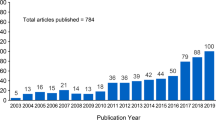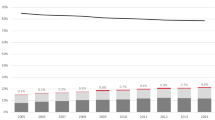Abstract
Summary
Despite targeted attempts to reduce post-fracture care gaps, we hypothesized that a larger care gap would be experienced by First Nations compared to non-First Nations people. First Nations peoples were eight times less likely to receive post-fracture care compared to non-First Nations peoples, representing a clinically significant ethnic difference in post-fracture care.
Introduction
First Nations peoples are the largest group of aboriginal (indigenous or native) peoples in Canada. Canadian First Nations peoples have a greater risk of fracture compared to non-First Nations peoples. We hypothesized that ethnicity might be associated with a larger gap in post-fracture care.
Methods
Non-traumatic major osteoporotic fractures for First Nations and non-First Nations peoples aged ≥50 years were identified from a population-based data repository for Manitoba, Canada between April 1996 and March 2002. Logistic regression analysis was used to examine the probability of receiving a BMD test, a diagnosis of osteoporosis, or beginning an osteoporosis-related drug in the 6 months post-fracture.
Results
A total of 11,234 major osteoporotic fractures were identified; 502 occurred in First Nations peoples. After adjustment for confounding covariates, First Nations peoples were less likely to receive a BMD test [odds ratio (OR) 0.1, 95% confidence interval (CI), 0.0–0.5], osteoporosis-related drug treatment (OR, 0.5; 95% CI, 0.3–0.7), or a diagnosis of osteoporosis (OR, 0.5; 95% CI, 0.3–0.7) following a fracture compared to non-First Nations peoples. Females were more likely to have a BMD test (OR, 5.0; 95% CI, 2.6–9.3), to be diagnosed with osteoporosis (OR, 1.7; 95% CI, 1.5–2.0), and to begin drug treatment (OR, 4.1; 95% CI, 2.7–6.4) compared to males.
Conclusions
An ethnicity difference in post-fracture care was observed. Further work is needed to elucidate underlying mechanisms for this difference and to determine whether failure to initiate treatment originates with the medical practitioner, the patient, or a combination of both. It is imperative that all residents of Manitoba receive efficacious and equal care post-fracture, regardless of ethnicity.

Similar content being viewed by others
References
Kanis JA, Johnell O, De Laet C et al (2004) A meta-analysis of previous fracture and subsequent fracture risk. Bone 35:375–382
Kanis JA, Johnell O, Oden A et al (2008) FRAX and the assessment of fracture probability in men and women from the UK. Osteoporos Int 19:385–397
Nevitt MC, Cummings SR, Stone KL et al (2005) Risk factors for a first-incident radiographic vertebral fracture in women > or = 65 years of age: the study of osteoporotic fractures. J Bone Miner Res 20:131–140
Giangregorio L, Papaioannou A, Cranney A, Zytaruk N, Adachi JD (2006) Fragility fractures and the osteoporosis care gap: an international phenomenon. Semin Arthritis Rheum 35:293–305
Papaioannou A, Kennedy CC, Ioannidis G, Gao Y, Sawka AM, Goltzman D et al (2008) The osteoporosis care gap in men with fragility fractures: the Canadian Multicentre Osteoporosis Study. Osteoporos Int 19:581–587
Papaioannou A, Morin S, Cheung AM, Atkinson S, Brown JP, Feldman S et al (2010) 2010 clinical practice guidelines for the diagnosis and management of osteoporosis in Canada: summary. CMAJ Can Med Assoc J 182:1864–1873
Metge CJ, Leslie WD, Manness LJ et al (2008) Postfracture care for older women: gaps between optimal care and actual care. Can Fam Phys 54:1270–1276
Leslie WD, Giangregorio LM, Yogendran M, Azimaee M, Morin S, Metge C, Caetano P, Lix LM (2011) A population-based analysis of the post-fracture care gap 1996–2008: the situation is not improving. Osteoporos Int. doi:10.1007/s00198-011-1630-1
Hodsman AB, Leslie WD, Tsang JF, Gamble GD (2008) 10-year probability of recurrent fractures following wrist and other osteoporotic fractures in a large clinical cohort. Arch Intern Med 168:2261–2267
Klotzbuecher C, Ross PD, Landsman PB et al (2000) Patients with prior fractures have an increased risk of future fractures: a summary of the literature and statistical synthesis. J Bone Miner Res 15:721
Cuddihy MT, Amadio PC, Gabriel SE, Pankratz VS, Kurland RL, Melton LJ III (2004) A prospective clinical practice intervention to improve osteoporosis management following distal forearm fracture. Osteoporos Int 15:695–700
Chevalley T, Hoffmeyer P, Bonjour JP, Rizzoli R (2002) An osteoporosis clinical pathway for the medical management of patients with low-trauma fracture. Osteoporos Int 13:450–455
Charalambous CP, Kumar S, Tryfonids M, Rajkumar P, Hirst P (2002) Management of osteoporosis in an orthopaedic department: audit improves practice. Int J Clin Pract 56:620–621
Leslie WD, Derksen S, Metge C, Lix LM, Salamon EA, Steiman PW, Roos LL (2004) Fracture risk among First Nations people: a retrospective matched cohort study. CMAJ Can Med Assoc J 171:869–873
Leslie WD, Derksen SA, Metge C, Lix LM, Salamon EA, Steiman PW, Roos LL (2005) Demographic risk factors for fracture in First Nations people. Can J Public Health Rev Can Sante Publique 96(Suppl 1):S45–S50
MacMillan HL, MacMillan AB, Offord DR et al (1996) Aboriginal health. CMAJ Can Med Assoc J 155:1569–1578
Epstein S, Leroith D (2008) Diabetes and fragility fractures—a burgeoning epidemic? Bone 43:3–6
Schwartz AV, Vittinghoff E, Bauer DC et al (2011) Association of BMD and FRAX score with risk of fracture in older adults with type 2 diabetes. JAMA 305:2184–2192
Roos NP, Shapiro E (1999) Revisiting the Manitoba Centre for Health Policy and Evaluation and its population-based health information system. Med Care 37:JS10–JS14
Roos NP (1999) Establishing a population data-based policy unit. Med Care 37(6 Suppl):JS15–JS26
Jebamani LS, Burchill CA, Martens PJ (2005) Using data linkage to identify First Nations Manitobans: technical, ethical, and political issues. Can J Public Health 96:S28–S32
Martens P, Sanderson D, Bond R, Jebamani L, Burchill C, Roos N, Tanner-Spence M, Derksen S, Leader A, Beaulieu M, Elias B, Steinbach C, O’Neil J, MacWilliam L, Walld R, Dik N (2002) The health and health care use of registered First Nations people living in Manitoba: a population-based study. Manitoba Centre for Health Policy, Winnipeg
Kozyrskyj AL, Mustard CA (1998) Validation of an electronic, population-based prescription database. Ann Pharmacother 32:1152–1157
WHO (2011) WHO Collaborating Centre for Drug Statistics Methodology. In www.whocc.no/atc/ (ed). Oslo, Norway. Accessed 15 Dec 2011
(2011) http://www.gov.mb.ca/health/bonedensity/. Government of Manitoba, Manitoba, Canada. Accessed 15 Dec 2011.
Leslie WD, Metge C (2003) Establishing a regional bone density program: lessons from the Manitoba experience. J Clin Densitom 6:275–282
Rossouw JE, Anderson GL, Prentice RL et al (2002) Risks and benefits of estrogen plus progestin in healthy postmenopausal women: principal results from the Women’s Health Initiative randomized controlled trial. JAMA 288:321–333
(2003) Income quintiles based on the 1996 census. http://mchp-appserv.cpe.umanitoba.ca/viewDefinition.php?definitionID=102882. Accessed 15 Dec 2011.
Demeter S, Leslie WD, Lix L, MacWilliam L, Finlayson GS, Reed M (2007) The effect of socioeconomic status on bone density testing in a public health-care system. Osteoporos Int 18:153–158
Starfield B, Weiner J, Mumford L et al (1991) Ambulatory care groups: a categorization of diagnoses for research and management. Health Serv Res 26:53–74
Smith NS, Weiner JP (1994) Applying population-based case mix adjustment in managed care: the Johns Hopkins Ambulatory Care Group System. Manag Care Q 2:21–34
Weiner JPSB, Steinwachs DM et al (1991) Development and application of a population-oriented measure of ambulatory care case-mix. Med Care 29:452–472
Reid RJ, Roos NP, MacWilliam L et al (2002) Assessing population health care need using a claims-based ACG morbidity measure: a validation analysis in the Province of Manitoba. Health Serv Res 37:1345–1364
Reid RJ, MacWilliam L, Verhulst L et al (2001) Performance of the ACG case-mix system in two Canadian provinces. Med Care 39:86–89
Leslie WD, Derksen S, Prior HJ, Lix LM, Metge C, O’Neil J (2006) The interaction of ethnicity and chronic disease as risk factors for osteoporotic fractures: a comparison in Canadian Aboriginals and non-Aboriginals. Osteoporos Int 17:1358–1368
Blanchard JF, Ludwig S, Wajda A et al (1996) Incidence and prevalence of diabetes in Manitoba, 1986–1991. Diabetes Care 19:807–811
Leslie WD, Lix LM, Prior HJ et al (2007) Biphasic fracture risk in diabetes: a population-based study. Bone 40:1595–1601
Cadarette SM, Gignac MAM, Jaglal SB, Beaton DE, Hawker GA (2007) Access to osteoporosis treatment is critically linked to access to dual-energy x-ray absorptiometry testing. Med Care 45:896–901
Frost M, Gudex C, Rubin KH, Brixen K, Abrahamsen B (2011) Pattern of use of DXA scans in men: a cross-sectional, population-based study. Osteoporos Int. doi:10.1007/s00198-011-1589-y
Rubin KH, Abrahamsen B, Hermann AP, Bech M, Gram J, Brixen K (2011) Prevalence of risk factors for fractures and use of DXA scanning in Danish women. A regional population-based study. Osteoporos Int 22(5):1401–1409
Neuner JM, Zhang X, Sparapani R, Laud PW, Nattinger AB (2007) Racial and socioeconomic disparities in bone density testing before and after hip fracture. J Gen Int Med 22:1239–1245
Glasgow RE, Klesges LM, Dzewaltowski DA, Estabrooks PA, Vogt TM (2006) Evaluating the overall impact of health promotion programs: using the RE-AIM framework to form summary measures for decision making involving complex issues. Health Educ Res 21:688–694
Glasgow RE, Garth McKay H, Piette JD, Reynolds KD (2001) The RE-AIM framework for evaluating interventions: what can it tell us about approaches to chronic illness management? Patient Educ Couns 44:119–127
Jilcott S, Ammerman A, Sommers J, Glasgow RE (2007) Applying the RE-AIM framework to assess the public health impact of policy change. Ann Behav Med 34:105–114
Sallis JF, Cervero R, Ascher WW et al (2006) An ecological approach to creating active living communities. Annu Rev Public Health 27:297–322
Acknowledgments
The authors acknowledge the Manitoba Centre for Health Policy for use of data contained in the Population Health Research Data Repository (HIPC project # 2000/2001-08). The authors are indebted to the First Nations and Inuit Health Branch and Aboriginal Affairs and Northern Development Canada for permission to use the Status Verification System and to the Health Information Research Committee of the Assembly of Manitoba Chiefs for actively supporting this work. The results and conclusions are those of the authors and no official endorsement by the Manitoba Centre for Health Policy, Manitoba Health, the Assembly of Manitoba Chiefs, or other data providers is intended or should be inferred. This article has been reviewed and approved by the members of the Manitoba Bone Density Program Committee.
Funding
This research was funded through an operating grant (ACB-65731) from the Canadian Institutes of Health Research (CIHR). Sharon L. Brennan was funded by a National Health and Medical Research Council (NHMRC) of Australian Early Career Fellowship (#1012472). Lisa M. Lix was funded by a CIHR New Investigator Award.
Conflicts of interest
William D. Leslie received speaker fees and research grants from Merck Frosst Canada Ltd and research grants from Sanofi-Aventis, Procter & Gamble Pharmaceuticals, Novartis, Amgen Pharmaceuticals, and Genzyme. He is also a member of the advisory board for Genzyme, Novartis, and Amgen Pharmaceuticals. Lisa M. Lix and Colleen Metge both received a research grant from Amgen. Authors Sharon L. Brennan, Heather J. Prior, and Brenda Elias declared that they have no competing interests.
Author information
Authors and Affiliations
Corresponding author
Rights and permissions
About this article
Cite this article
Leslie, W.D., Brennan, S.L., Prior, H.J. et al. The post-fracture care gap among Canadian First Nations peoples: a retrospective cohort study. Osteoporos Int 23, 929–936 (2012). https://doi.org/10.1007/s00198-011-1880-y
Received:
Accepted:
Published:
Issue Date:
DOI: https://doi.org/10.1007/s00198-011-1880-y




